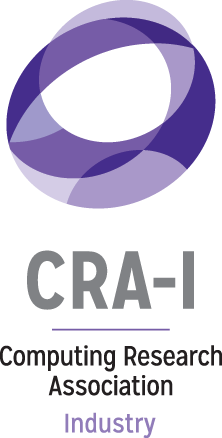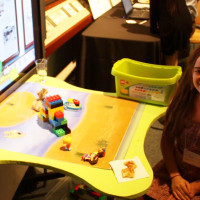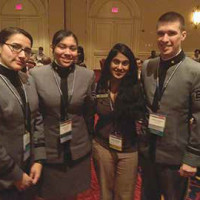Interview with Jan Cuny
Originally Printed in the Winter/Spring 2013 Newsletter
Jan Cuny is a Program Officer at the National Science Foundation, where she leads the Computing Education and Workforce cluster. The cluster runs two programs:
Broadening Participation in Computing Alliances (BPC-A) and Computing Education for the 21st Century (CE21). Both aim to build a thriving computing research community, a diverse and computationally competent 21st century workforce, and a computationally empowered citizenry. Before coming to NSF in 2004, Jan was a faculty member in the Computer Science departments at Purdue University, the University of Massachusetts, and the University of Oregon.
Jan has been involved in efforts to increase the participation of women and minorities in computing research for many years. Before joining NSF, she was a long-time member of CRA-W, a member of the Advisory Board for Anita Borg Institute for Woman and Technology, the Leadership team of the National Center for Women & Information Technology (NCWIT), the Executive Committee of the Coalition to Diversify Computing (CDC), and the Board of Directors of the Computing Research Association (CRA). For her efforts with underrepresented populations, Cuny received an ACM President’s Award in 2006, the A. Nico Habermann Award from the CRA in 2007, and the 2009 Anita Borg Institute’s Woman of Vision Award for Social Impact.
Q: In your current role at NSF, what are your newest goals and opportunities to make an impact?
I came to NSF to work on broadening participation in computing. Not just to include more women, but to also include proportional numbers of people from the other underrepresented groups—African Americans, Hispanics, Native Americans, and people with disabilities. Together, this encompasses 70% of our population. Their lack of participation is both a loss of opportunity for those individuals, and a loss of much needed talent and creativity for our nation. Changing the demographics of computing is not going to be easy. It will require a sustained effort, but being at NSF gives me an opportunity to spur and facilitate some of that change.
Right now, I’m most excited about the opportunity we have to get rigorous, academic computing courses into high schools. Most U.S. high schools offered only the most basic computer-related courses (often teaching just keyboarding and the use of office products). On average, these courses are so weak that the NCAA doesn’t even count them towards eligibility for sports – a very low bar. This lack of CS at the high school level differentially affects girls and minorities because they do not see counter examples to the popular misconceptions that IT is just for geeky guys, that computing has no societal benefits, and that all of the good CS jobs have already moved off shore. I see the lack of access to rigorous CS courses as an equity issue. I don’t think we will be able to make computing really inclusive without first tackling high school curriculum.
NSF is building the foundation for a project, called CS 10K, that plans to get 10,000 well-prepared teachers teaching rigorous, academic computing courses in 10,000 schools by 2017. To catalyze this effort, NSF has funded the development of curricula for two new courses, both designed to be conceptually-based, rigorous, accessible, and inspiring. By inspiring, I mean the courses are designed to engage students, to help them see the societal benefits of computing, and show them this will be useful to their lives after high school graduation. NSF is now supporting the development of assessments and materials for these courses, as well as models of professional development (PD) and online supports and communities for teachers to collaborate. Taking these foundational efforts and scaling them to10,000 though will not be easy. It will take policy changes at the state and local level, advocacy within schools and school districts, an unprecedented focus on PD, and significant resources—things that are well beyond the mission and resources of NSF as the sole agent for change. We’ll need to rely on private partnerships. Already ACM, CSTA, NCWIT, and the College Board are playing key roles but we will need all hands on deck to be successful. Contact me if you’d like to help.
The CS 10K Project project is big, complex, and really challenging. It’s fun and energizing for me personally, but more importantly, I believe it could well change the world for many students.
Q: You created the incredibly successful BPC program at NSF. What were the challenges in bringing that about? Has the program grown the way you envisioned? What remaining goals do you have for BPC?
The first challenge was building the networks of people who would collaborate to begin the work. I needed Principal Investigators, reviewers, and advisors—hundreds of people in all. The best part about being at NSF is getting to know and work with these generous people. They’re inspiring, and they have been great partners. BPC has funded small projects to test novel interventions and large national Alliances —including NCWIT, STARS, CAHSI, CRA-W/CDC, AccessComputing, ECEP—that are sustained efforts providing resources, advocacy, outreach, and direct services to the computing community. The BPC community itself has grown to more closely resemble a traditional re-search community: they’ve increased the rigor of their evaluations and assessments, built strong networks, met regularly, and more intentionally leveraged each others’ work. Two years ago, BPC was merged into NSF’s education efforts, to form the Computing Education for the 21st Century (CE21) program. That program has challenged the BPC community to think more about capacity building in their interventions, to interact more with the CS Education community, and to incorporate and contribute to educational research on the teaching and learning of computing.
The longstanding underrepresentation of so many in computing has multiple causes, some deeply seeded in our society. Changing it will take a sustained effort. My goal now is to ensure that that effort continues, matures, and grows to involve more members of the computing community.
Q: What was your path (background) that brought you to this point in your career? What made you choose computer science in the first place? What made you choose an academic career when you started out? Finally, what attracted you to move into a career at NSF?
I went to Princeton as an undergraduate, (and I’m dating myself here) in its first class of women. I arrived there liking math, international relations, chemistry, and religion. Computer science wasn’t on my radar at all, but it was on my boyfriend’s. He’d started taking CS courses, and when I visited him on weekends, I’d invariably get stuck hanging around, waiting for him to finish up one program or another. I was in-trigued. I decided to write my own program and, improbably – knowing almost nothing about programming or programming languages – I decided that my program would be a compiler. By the time I’d finished, I knew IBM 360 Assembly Language inside out and backwards, and had taken courses in computer architecture, data structures, algorithms, and parsing. That is, without making any career decisions at all, I found myself well on the way to completing a CS major. I was undeterred by the fact that I had not seen a single female professor or even another female student in any of my CS classes. I was also undeterred by the fact that Princeton, while offering CS courses, didn’t offer a CS major. Eventually, I got together a small group of faculty who agreed to form an ad hoc depart-ment on my behalf and I graduated with a CS degree, though my diploma lists “Independent” as my major.
When I graduated I was certainly not thinking about an academic career, but I was nervous about my qualifications for any real job. Graduate school seemed like a reasonable next step. I went to the University of Wisconsin, and while serving as a TA there, fell in love with teaching. After getting my master’s, thinking that a Ph.D. would offer more job security, I decided to continue without really having much of a commitment to a research career. I got married, transferred to the University of Michigan as a Ph.D. student, and then drifted for a while, trying to get started on a thesis topic. That ended when my adviser – Bill Rounds – decided that several of us would meet most afternoons one summer to discuss our research. We’d spend the entire afternoon on topics of one person’s choosing and we’d rotate between members of the group. The pressure was on. But by the end of the summer, I’d fallen in love with research, proved several theorems, and developed a thesis topic. I realized that not only did I want to teach, I wanted to be a professor at a research institution. I did exactly that for 23 years, first at Purdue, then UMASS, and finally at the University of Oregon.
Q: Explain a bit about your technical interests and how your research evolved over time.
Though I arrived at graduate school interested in program-ming languages, I quickly became intrigued by the implications of parallelism. My thesis was a theoretical analysis of synchronization primitives. As a new faculty member, I worked with Ph.D. students on ways to specify parallelism based on graph grammars, and on ways to understand and debug parallel code—in particular ways to detect higher level patterns of interaction during asynchronous execution. When I moved to the University of Oregon, I got involved in an effort to get a large, parallel machine for our campus and through that effort met many of the scientists who wanted to use the machine. The difficulties they and their students had led me to look at programming environments that better supported scientists in generating and composing parallel codes. I worked mainly with geologists. They have much better field trips than computer scientists.
Q: What role has professional service played in your career?
I have always done lots of professional service – mostly around equity issues – and I’ve enjoyed it. I do think it has an impact on our field. It also allowed me to make a wide range of professional contacts and personal friends. It has added color to my career.
Q: What do you enjoy most about your career right now? What drives you at this point in your career?
Changing the status quo of computing in high schools is a complex and challenging endeavor. There are lots of people and organizations involved and lots of moving pieces. It’s fun. What drives me now is the belief that all of these pieces will fall together, that we could make a lasting change for our field. That it is, as someone recently told me, all “plausibly possible.”
Q: What challenges have you had to overcome as a woman leader in the field? What is the most difficult aspect of your career right now?
The most obvious challenges in my life were challenges that both genders face: the challenges of having an intense, consuming career at the same time one is trying to have a life and particularly, at the same time one is trying to parent children. I know that women, especially women in male-dominated fields like CS, frequently face the additional challenges of increased scrutiny, chilly climates, and subtle, though often unconscious, discrimination. In college and my early faculty positions, I was blissfully unaware of any of that. It’s not that it didn’t affect me, it’s just that I wasn’t paying attention. It wasn’t until much later that I became more aware of the lack of women in technical meetings, more aware of the impact that subtle discrimination had on some female students that I knew, and more aware of the statistics that show long term career impact. BPC—especially through its funding of organizations like CRA-W and NCWIT—aims to level this playing field.
Q: Looking back over your entire career, what accomplishments are you most proud of ? Looking forward, what might be your next big thing?
In terms of my career, I am most proud of BPC. I’m confident that the people that BPC brought together will make a lasting difference in our discipline. My primary effort now is the CS 10K Project, but of course, the final word on that is not yet in. But once that works, it would rival BPC as my most significant accomplishment.
Q: How have you been involved in CRA-W? What has this involvement meant to you?
Fran Berman talked me into joining CRA-W, promising that it would be fun, and that I’d get to hang out with incredible women. She also assured me it would be hardly any work at all and they’d let me choose the next meeting site (I chose Albuquerque). She was only partially right: it was fun and I did get to hang out with incredible women. It was a ton of work though. Over the next decade, I organized the Career Mentoring Workshops, co-founded the Grad Cohort and CAPP Programs with Mary Lou Soffa, and served as Co-chair and on the Steering Committee. But we never did get to Albuquerque.
Through CRA-W, I was able to impact the field of CS well beyond my university, and I met lots of people in the CS community. This much larger network led to other opportunities: I got to know many department chairs while representing CRA-W at the CRA SnowBird meetings and through them, got elected to the CRA Board; I got to know Peter Freeman while serving on the Board, and ultimately he hired me at NSF.
Q: Describe your involvement in other volunteer organizations that support women in computing.
Through my time with CRA-W, I met lots of terrific women in computing and got to be part of the leadership team of the National Center for Women & Information Technology (NC-WIT). It’s a terrific organization that has grown to represent and support women in all aspects of IT from K-12 through the career ranks. I also worked with the Anita Borg Institute, serving on its Board of Advisors, as the Program Chair for GHC 2004, and as the General Chair for GHC 2006.
Q: How do you balance work and family life? Do you have any advice about the challenges for 2-career couples?
My husband, Steve, and I met in college and we married while we were in grad school. Our first taste of reality came as we finished our Ph.D.s and noticed that the list of schools where he wanted to post doc and the list of schools where I wanted to work did not intersect at all! Steve ended up doing a postdoc
at the University of Chicago and I ended up, 120 miles away, at Purdue. Lots of time spent on I-91. After Steve’s postdoc, we both got jobs as assistant professors at UMass. Over the Jan and her son, Cisco, look over campaign data next few years, we adopted three older kids—aged 6, 2, and 1—and life got pretty chaotic. Steve stepped in to solve the problem by becoming a stay-at-home dad. I’d come home and the kids would be happy, homework done, and dinner on the table. It was great and it made picking up and leaving for my sabbatical in Seattle, doable and fun. After a year back at UMass, we missed the Northwest, and so I took a job at the University of Oregon and we all headed to Eugene. As the kids got older, Steve worked part time as a researcher and then volunteered in the local schools, where he found his calling. He became a science teacher in middle school and high school. After our youngest went off to college, I took a temporary job (for two years, I thought) at NSF. After the first year, Steve came to D.C. on a one-year Einstein Fellowship, working on education issues in the office of then-Senator Obama. When it came time to return to Oregon at the end of that year, we didn’t. Today, we are still in D.C. where I continue to work for NSF (now a permanent employee) and Steve works in the Obama White House, on the Domestic Policy Council. Recently, my 13-year-old granddaughter moved in with us, giving us another shot at parenting through those teenage years.
I mention all this because I think it’s typical of many dual career families—lots of changes, lots of juggling, and a mix of wins and losses. All in all though, I think we’ve done a good job at sharing parenting and at supporting each other’s careers. It took flexibility, lots of work, and when the kids were young, terrific daycare.
Q: What activities do you pursue outside of work?
I’ve always enjoyed volunteering. I’ve been a big sister and mentor to kids living in institutional settings, and led Brownie Troops. Before moving to D.C., my most significant, multiyear commitment was as a CASA (Court Appointed Special Advocate) to 12 kids in the foster care system. I worked with their biological, foster, and eventually adoptive families; I advocated for them with their school and with their doctors; I represented their interests in court whenever legal decisions were being made; and I went to countless sporting and school events to cheer them on. After we moved to D.C., I mentored in several after-school programs, and—as befitting someone in D.C.—became involved in politics. I volunteered for a Senate campaign to get the lay of the land, and then took long leaves of absence to work on each of the last two presidential campaigns. (There were definitely some peak experiences and things to be proud of in that work!)
Outside of volunteering, I like to quilt, practice Tai Chi, and spend time at a small cabin we have on a river in the Oregon Cascades. And to keep things totally in balance (well, maybe not totally), I spend 10 days almost every year on a completely silent retreat at a monastery in the Colorado Rockies.






